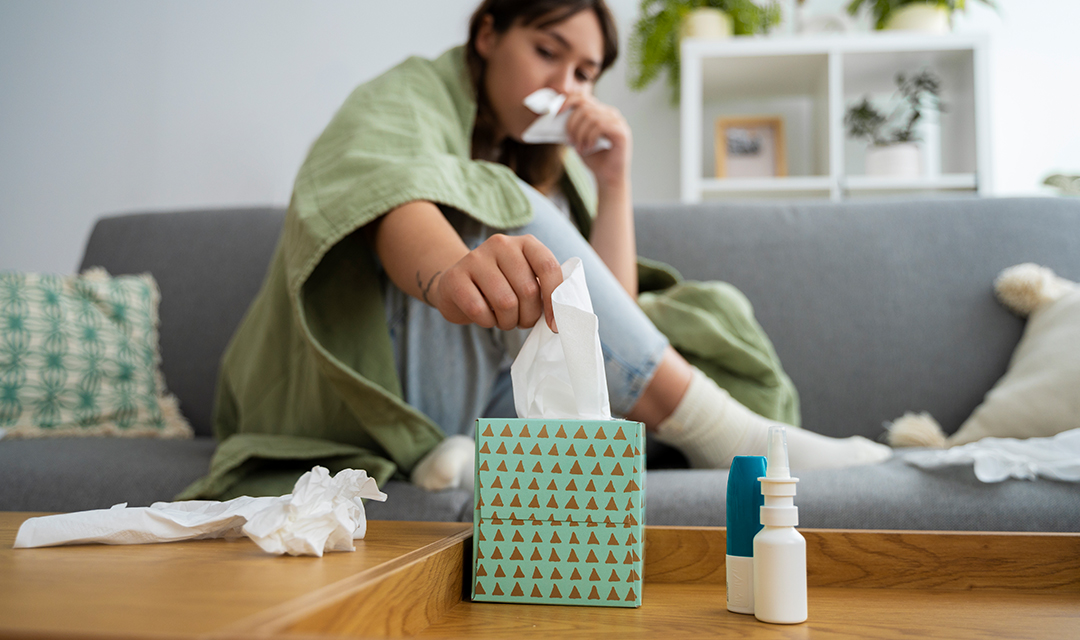Insight Allergy & Immunology – When we think of allergens, we often think of trees, grasses, weeds, and other outdoor sources that cause itchy eyes and sneezing in the spring and summer months. But did you know there are also many indoor allergens that can trigger allergies and asthma in your own living environment year round? With windows closed and forced air furnaces circulating these allergens throughout our homes, allergy sufferers often experience symptoms like a stuffy nose, sneezing, and itchy eyes as soon as colder weather sets in. Whether you have noticed a recurrence of allergy symptoms in the colder months or are interested in learning more about keeping allergens in your home at bay, here is a brief overview of indoor allergens, as well as some tips on how to manage them.
What are Indoor Allergens?
Indoor allergens are any substances found indoors that can cause allergic reactions in people sensitive to allergens. Indoor allergens are typically airborne but can also be found on surfaces. Some of the most common indoor allergens include dust mites, which thrive on carpeting and furniture, as well as pet dander and mold spores that grow in damp environments like basements. Although pollen is typically considered an outdoor allergen, it can also easily enter indoor environments through open doors and on our clothing.

How Do I Know if I’m Experiencing Indoor Allergies?
Indoor allergy symptoms are similar to typical seasonal allergy symptoms. Sneezing, runny nose, stuffy nose, itchy eyes, throat irritation, and difficulty breathing while indoors are all common signs of indoor allergies. Symptoms tend to worsen during activities that disturb allergens, such as dusting and vacuuming, or while in certain areas of your home (e.g. damp basements). In the colder months, it can sometimes be difficult to determine if you are experiencing allergies or a cold. As a rule of thumb, allergies tend to last longer than a cold or flu, do not produce thick mucus or fever, and are not contagious.

Where are Indoor Allergens Typically Found?
Indoor allergens can be found throughout your home. Dust mites thrive in warm, humid environments such as bedding and mattresses. They are also common in carpets and upholstered furniture, along with pet dander from dogs, cats, and other animals with fur. HVAC symptoms (both heating and cooling) circulate allergens throughout the home, especially when filters are not regularly cleaned or installed. Damp areas, such as basements and bathrooms, can harbor mold if not ventilated properly.

What Can I Do To Manage Indoor Allergens?
Vacuuming carpets, furniture, and other surfaces at least once a week is one of the best ways to eliminate indoor allergens. Bedding should also be washed in hot water weekly to remove any dust mites and pet dander. HVAC systems should be maintained regularly, including professional cleanings once a year and air filter replacement every one to three months. HEPA air purification systems can also help remove allergens from indoor environments. Mold allergens can be managed by using exhaust fans and dehumidifiers in mold-prone rooms like basements and bathrooms. Also watch for any small leaks in your home that could be contributing to a damp environment.
When Should I Get Professional Help for Treating Indoor Allergies?
Mild indoor allergies can typically be treated by following the above preventive measures and using over the counter medications such as antihistamines. If your symptoms persist and are impacting your quality of life, it may be time to consider visiting an allergy specialist. Allergists are able to identify specific triggers through testing and can provide a tailored treatment plan to meet your unique needs.

Although it’s not possible to eliminate all indoor allergens, understanding what they are, where they are located in your home, and taking steps to reduce your exposure to them can significantly improve your quality of life in any season. If you’re suffering from allergies and are interested in learning more about treatment options, the team at Insight Allergy & Immunology can help you find relief. Contact us today to schedule an appointment at one of our convenient locations in Flint, Warren, and Dearborn.
Frequently Asked Questions About Visiting an Allergy Specialist
Q: How do I know when it is time to see an allergy specialist?
A: You should consider seeing an allergy specialist when over the counter treatments are not alleviating your symptoms, your allergies are interfering with daily life, or you are experiencing unusual or severe symptoms (e.g. trouble breathing, hives).
Q: What can I expect when I see an allergist?
A: On your first visit to an allergy specialist, your physician will ask about your symptoms, triggers, and family history of allergies. Depending on your symptoms, a physical exam may occur to assess signs of allergies such as skin conditions. Testing, including skin prick tests and blood tests, may also be necessary. Finally, your physician will recommend a treatment plan that may include medications, lifestyle changes, and further testing.
Q: Is allergy testing painful?
A: Allergy testing is usually not painful. During skin prick testing, a small amount of an allergen is placed on your skin and a tiny needle pricks the surface. This may cause mild irritation if you are allergic. Blood testing requires drawing a small amount of blood to measure your immune system’s response to allergens and is not painful.

